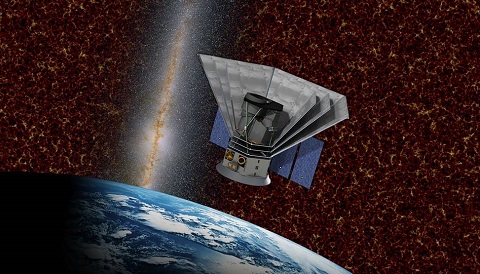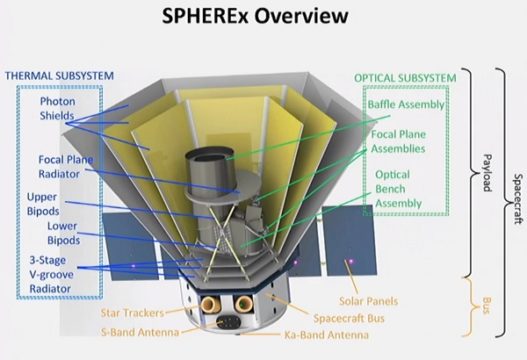The SPHEREX mission will create multiple surveys of the near-infrared sky that will reveal the origins of life and perhaps the universe itself.

Caltech
NASA recently announced the selection of a new mission that will probe the universe's earliest moments, catalog the evolution of galaxies, and survey just how common the ingredients for life are in galactic stellar nurseries.
The mission is called the Spectro-Photometer for the History of the Universe, Epoch of Re-ionization and Ices Explorer (SPHEREX) and is funded at $242 million, not including the launch vehicle. Slated to launch in 2023, SPHEREX is approved for a two-year mission to conduct a spectral survey of the visible and infrared sky. The data it collects will be available to the public through Caltech's Infrared Processing and Analysis Center.
“With this announcement, we look forward to building SPHEREX,” says Principal Investigator James Bock (Caltech) in a recent press release. Selected as part of NASA's long-running Medium-Class Explorers program, SPHEREX beat out the Fast Infrared Exoplanet Spectroscopy Survey Explorer (FINESSE) and the proposed Arcus X-ray observatory.
A Unique All-Sky Survey
To accomplish its mission, SPHEREX will employ a specialized, 8-inch (20-centimeter) telescope that will survey the sky at visible and near-infrared wavelengths. As it obtains spectra from 0.75 to 5 microns every six months during its nominal mission, over the course of its two-year mission SPHEREX will essentially build four all-sky surveys in 96 color bands. In doing so, it will create the first spectral all-sky survey at infrared wavelengths. SPHEREX's wide, 7.5° by 3.5° field of view and 6-arcsecond-wide pixels enable it to surpass previous survey efforts.
SPHEREx will accomplish its mission from a low-Earth polar orbit, also known as a Sun-synchronous orbit.

Caltech
As an added bonus, SPHEREx could also characterize groups of Jovian Greek and Trojan asteroids trailing and following Jupiter in its orbit, data that would complement NASA's Lucy mission, which will head to several Trojan asteroids in 2021.
SPHEREX Science Goals
The mission has multiple science goals that range from cosmology to the origins of life. As part of its surveys, SPHEREX will refine distance estimates for more than 450 million galaxies, looking back as far back in time as 10 billion years. Crucially, SPHEREX will see back to the period known as the Epoch of Re-ionization, the era 400 million to 1 billion years after the Big Bang when the first stars were born, and constrain the parameters of early galaxy formation. The mission will also map out galaxies closer to home, examining large volumes in detail to determine what drove the period of inflation in the early universe.
The SPHEREX survey is also expected to reveal water and organic molecules in the stellar nurseries within our own galaxy, cataloging ices in every stage of star and planet formation from molecular clouds to protoplanetary disks. Ice reservoirs are thought to be the source of the water that ultimately made its way — either internally, from hydrated minerals, or externally, from comets — to early Earth.

Caltech
SPHEREX will also complement other up-and-coming spectroscopic surveys, including WFIRST, launching in the 2020s, and the European Space Agency's Euclid space telescope, launching in 2022. The SPHEREX all-sky survey is also expected to find objects of further interest for the James Webb Telescope, now slated to launch in 2021.
The SPHEREX mission is part of an exciting new generation of space telescopes lifting off in the coming decade that will open a window onto the early universe, and point the way towards tracing the building blocks of life.
Learn more details on the mission in this in-depth discussion on SPHEREX with Principal Investigator James Bock (Caltech).
 3
3









Comments
Peter Wilson
February 20, 2019 at 9:33 am
Watched a YouTube doc. last night about, "the James Webb Telescope, slated to launch in 2018..." Sigh
You must be logged in to post a comment.
Rod
February 22, 2019 at 1:01 pm
"The SPHEREX mission will create multiple surveys of the near-infrared sky that will reveal the origins of life and perhaps the universe itself." I am reminded of this quote:
"There are only 3 options for the origin of this universe: 1) it has always existed 2) it suddenly appeared from nothing 3) it was created supernaturally - “It is then tempting to go one step further and speculate that the entire universe evolved from literally nothing.” - Guth & Stienhardt, May 1984, Scientific American".
You must be logged in to post a comment.
Eric Rachut
February 22, 2019 at 6:20 pm
Speaking of evolving from nothing, I wish the contents of my wallet had that ability.
You must be logged in to post a comment.
You must be logged in to post a comment.